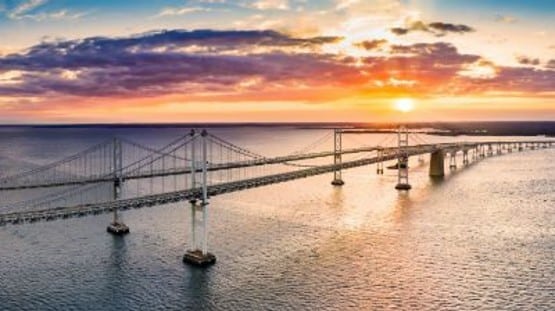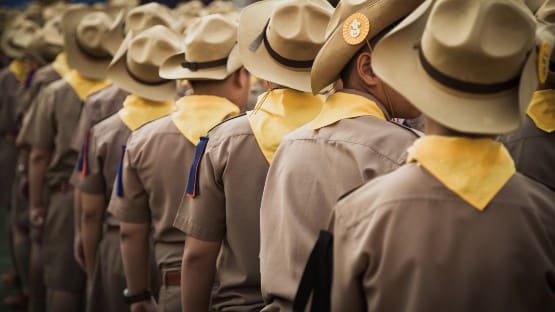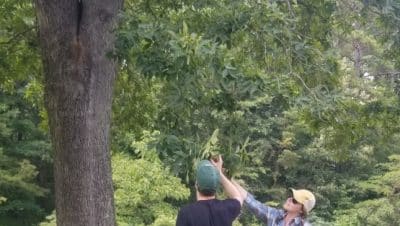
The Chesapeake Bay’s underwater meadows continued to expand in 2022, aided in part by cooler temperatures that prompted a resurgence of heat-sensitive beds in parts of the lower Bay.
It was the second straight year underwater grass beds expanded after losing 42% of their acreage following a protracted period of heavy rain in late 2018 and early 2019 that left the Bay awash in water-clouding sediment and algae blooms.
“It was a good year,” said Chris Patrick, director of the submerged aquatic vegetation monitoring and restoration program at the Virginia Institute of Marine Science, who oversees the annual aerial survey.
Overall, the grasses edged up 12% to 76,383 acres last year, after a 7% increase in 2021.
Underwater grass beds generally expanded in mid– and high-salinity areas of the Bay, he noted, with more mixed results in lower salinity and freshwater areas.
Bay grasses, also known as submerged aquatic vegetation, or SAV, provide important habitat for juvenile blue crabs and fish, as well as food for waterfowl. The plants also provide a host of other services, pumping oxygen into the water while their roots help stabilize sediment and their leaves buffer wave action.
But they require clear water to get the sunlight needed to survive. When sediment, driven off the land by rain, and nutrient-fueled algae blooms cloud the water, the beds can die off.
Because underwater grasses are so important, Bay cleanup goals are aimed in part at creating conditions that allow them to thrive. Their annual abundance is a closely watched indicator of how the Chesapeake is doing.
Last year’s coverage was nearly double the 38,958 acres observed in the first annual survey in 1984. But it was well below the restoration goal of 185,000 acres set by the state-federal Bay Program and the high of 108,077 acres observed in 2018 before the heavy rains hit.
Generally, grasses in recent decades have been recovering in freshwater and low-salinity areas of the upper Bay and the upper reaches of its tidal tributaries. In many of those areas, they are even near their restoration goals.
Nowhere is that comeback more dramatic than in the Susquehanna flats, located near the mouth of the Chesapeake’s largest tributary, which was nearly void of grasses when the survey began but now has the largest bed in the Bay. Last year, it had roughly 10,500 acres, up a couple of hundred acres from the year before.
But the in the mid– and high-salinity areas of the middle and lower portions of the Chesapeake — where more than 80% of potential SAV habitat is found — the story is different. Unlike low-salinity areas that support many types of grass, areas with higher salinity have only two main species: eelgrass and widgeon grass.
Eelgrass, which is sensitive to heat, has seen sharp reductions as temperatures have warmed, while widgeon grass has become more abundant. But widgeon grass fluctuates widely from year to year. As a result, there has been no strong trend in those areas over the last two decades.
The 2022 survey showed that:
- The tidal freshwater areas at the head of the Bay and in the uppermost tidal reaches of most tributaries held mostly steady, with 19,179 acres in 2021 and 19,185 acres mapped last year. That is 93% of the restoration goal for that area.
- The slightly salty “oligohaline” waters, which occupy a relatively small portion of the upper Bay and tidal tributaries, showed a decrease from 8,384 acres to 7,145 acres, a loss of about 15%. That is 69% of the restoration goal for that area. Almost all of the loss was concentrated in a small area between the Gunpowder and Middle rivers on Maryland’s upper Western Shore, where scientists suspect a localized event led to the decline.
The moderately salty “mesohaline” waters — the Bay’s largest area of potential underwater grass habitat, stretching from near Baltimore south to the Rappahannock River and Tangier Island in Virginia, including large sections of most tidal rivers — saw an increase from 24,091 acres to 30,932 acres, or 28%. Still, that is just 26% of the restoration goal for that area.
The very salty “polyhaline” water in the lower Bay — from the mouth of the Rappahannock and Tangier Island south, including the lower York and James rivers — had an increase from 16,371 acres to 19,200 acres, or about 17%. That is 57% of the restoration goal for that area.
The rebound in the salty and very salty areas, from Baltimore south, was driven both by the expansion of widgeon grass and a reversal in the long-term decline of eelgrass, scientists said.
“The last couple of years have not seen that intense heat,” said Brooke Landry, a biologist with the Maryland Department of Natural Resources and chair of the Bay Program’s SAV Workgroup. “And so, it makes sense that eelgrass is going pretty well.”
Patrick attributed at least part of the comeback to a faraway cause: A La Nina climate pattern that has existed in the Pacific Ocean the last couple of years contributed to cooler temperatures in this region.
That, in turn, led to an expansion of eelgrass. Eelgrass, once the Bay’s dominant underwater grass species, is not tolerant of warm temperatures and has been in decline in the Chesapeake for the last quarter century.
The good news could be short-lived, though. An El Nino, which has the opposite effect of a La Nina, is forming in the Pacific, and Patrick said he is concerned that could produce hotter temperatures next year.
“As we’re in this La Nina period, it’s going to be cool,” Patrick said. “That’s good for eelgrass. When we switch to El Nino, it’s likely to get a lot hotter, potentially the hottest summers we’ve ever seen, and that can’t be good for eelgrass.”
Karl Blankenship is editor-at-large of the Bay Journal. You can reach him at [email protected]. This article first appeared in the July/August 2023 issue of the Bay Journal and was distributed by the Bay Journal News Service.









